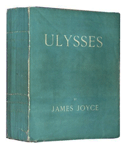 The New Year’s festivities are just behind us and with these the celebrations around Public Domain Day 2012 that took place in different cities in and outside Europe (Warsaw, Zurich, Turin, Rome, Haifa etc.).
The New Year’s festivities are just behind us and with these the celebrations around Public Domain Day 2012 that took place in different cities in and outside Europe (Warsaw, Zurich, Turin, Rome, Haifa etc.).
2012 brings with it the joy of using James Joyce’s masterpieces without asking the estate for prior authorization (which more often than not met with a ‘no’ for an answer!). No one needs to be afraid of using the works of Virginia Woolf any longer! And the fans of Arsène Lupin, the French ‘gentleman burglar’, are now able to borrow – for good! – the ideas of its author, Maurice Leblanc. The works of several music composers are also free for reuse, including those of Frank Bridge and Johan Wagenaar.
The Public Domain Day IS important and SHOULD be celebrated annually, for it gives us the occasion to reflect on the significance of works of past authors and to measure the wealth of our common knowledge and culture. But unlike the New Year’s celebrations, however, those of the Public Domain Day do not attract much attention among the general public. Festivities of this sort are usually low-key, taking place in libraries, universities or cafés and gathering only the selected few of the well informed and culturally savvy.
Any cramped optimism concerning the public domain is further discouraged by the fact that the term of protection for copyright and related rights is 1) highly unharmonized across jurisdictions and 2) still being strechted beyond recognition through constant legislative action.
As an illustration of the first point, let me mention the case of world famous writer Ernest Hemingway (1899-1961) whose works have fallen into the public domain two days ago in Canada, but neither in his home country, the United States, or in Europe, where copyright lasts for the life of the author + 70 years.
In Europe, the calculation of the term of protection for copyright and related rights is rendered particularly complex due to the lack of proper harmonisation of the governing rules in EU jurisdictions. Although the adoption of the EC Term Directive was an attempt to alleviate disparities between the Member States, harmonisation gaps persist. As a result, the composition of the public domain will differ depending on the country in which protection is sought, as works fall out of copyright on different dates in different EU jurisdictions. This effect is illustrated in the Public Domain Calculators by the need for separate calculators, giving upon occasion very different results, for each of the 30 jurisdictions covered, including the 27, ostensibly harmonised, EU Member States.
In relation to the second point, 2012 will inevitably see the first pieces of national legislation emerge in the EU Member States towards the implementation of Directive 2011/77/EU amending Directive 2006/116/EC on the term of protection of copyright and certain related rights. Through this statutory amendment only sound recordings published or communicated to the public before 1941 will be free for use. In practical terms, this means that none, not even the early recordings, of Maria Callas will be available for re-use without prior authorization of the record company holding the rights.
Finally, the march towards term extension does not seem to have reached its limit if one only takes a look at the clauses contained in bilateral and mulilateral trade agreements currently negotiated by the United States. Article 4.5 of the Trans-Pacific Partnership, for example, would bring the copyright term of protection of signatory countries up to the American (and European) level, as has been the case in the past in the context of bilateral agreements (with Australia and many countries of Central and South America, to name but these).
These are very sobering thoughts indeed! If the alcohol fumes of the New Year’s party still had any effect, one could even be tempted, for simplicity’s sake, to just make copyright protection perpetual…
_____________________________
To make sure you do not miss out on regular updates from the Kluwer Copyright Blog, please subscribe here.
Kluwer IP Law
The 2022 Future Ready Lawyer survey showed that 79% of lawyers think that the importance of legal technology will increase for next year. With Kluwer IP Law you can navigate the increasingly global practice of IP law with specialized, local and cross-border information and tools from every preferred location. Are you, as an IP professional, ready for the future?
Learn how Kluwer IP Law can support you.



We at the Wikimedia Commons do celebrate this day, of course. Here’s a list of links to lots and lots of new uploads: http://commons.wikimedia.org/wiki/User:FA2010/PD2012
Btw, it’s funny to read a lament on copyright politics on a Wolters Kluwer site, of all places.